 W
WAbgoosht is an Iranian stew. It is also called dizi, which refers to the traditional stoneware crocks it is served in. Some describe it as a "hearty mutton Persian soup thickened with chickpeas."
 W
WAush jushpare is a type of aush, commonly cooked in Khorasan, Gonabad, Ferdous and Sabzevar in Iran. It is similar to the Chinese Jiaozi Historian Bayhaqi (-1077) mentioned about Aush Jushpare in his book "Tarikh-i Bayhaqi". Aush Jushpare is one of the oldest Aush, but since it takes a lot of time for preparation, it is not commonly eaten now. It is rather a dish of hospitality, which people eat on the occasion of special gatherings or festivals. Traditional guest house restaurant serves Aush Jushpare as local specialty. Aush Jushpare was registered as intangible heritage of Iran on 5 January 2021.
 W
WBorek or burek is a filled pastry made of a thin flaky dough such as filo with a variety of fillings, such as meat, cheese, spinach or potatoes. Boreks are mainly associated with the areas of the former Ottoman Empire, including the Balkans and the Caucasus, the Middle East, Eastern European and Central European countries, Northern Africa and Central Asia. A borek may be prepared in a large pan and cut into portions after baking, or as individual pastries. They are usually baked but some varieties can be fried. Borek is sometimes sprinkled with sesame or nigella seeds, and they may be served hot or cold.
 W
WA cabbage roll is a dish consisting of cooked cabbage leaves wrapped around a variety of fillings. It is common to the cuisines of Central, Northern, Eastern and Southeastern Europe and much of Western Asia, Northern China, as well as parts of North Africa. Meat fillings are traditional in Europe, and include beef, lamb, or pork seasoned with garlic, onion, and spices. Grains such as rice and barley, mushrooms, and vegetables are often included as well. Fermented cabbage leaves are used for wrapping, particularly in southeastern Europe. In Asia, seafoods, tofu, and shiitake mushrooms may also be used. Chinese cabbage is often used as a wrapping.
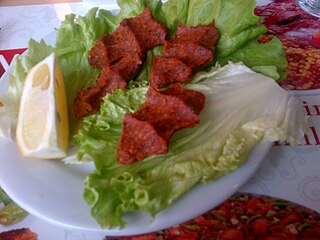 W
WÇiğ köfte or chee kofta is a köfte dish that is a regional specialty of Şanlıurfa and Adıyaman in southeastern Turkey served as an appetizer or meze. Similar to kibbeh nayyeh from Lebanese cuisine, çiğ köfte is common to Armenian and Turkish cuisines, and is also found in the traditional cuisine of the Urfalim Jews.
 W
WDolma is a family of stuffed dishes from Ottoman cuisine that can be served warm or cold. Some types of dolma are made with whole vegetables, fruit, offal or seafood, while others are made by wrapping leaves, most commonly grape or cabbage leaves, around the filling. Wrapped dolma, specifically, are also known as sarma.
 W
WEetch is a traditional Armenian side dish, salad or spread, similar to tabbouleh. made principally from bulgur. Eetch can be eaten either at room temperature or warm.
 W
WGhapama is an Armenian stuffed pumpkin dish, often prepared during the Christmas season. It is prepared by removing the guts of the pumpkin and stuffing it with boiled rice and dried fruits such as chopped almonds, apple, cornel, apricot, plums, dates, prunes and raisins. It is also common to pour on honey and mix in ground cinnamon or sugar. The pumpkin is then baked until it becomes soft, then brought to the table where it is cut up and served.
 W
WGomgush is a traditional Armenian banquet stew, resembling dzhash (Ճաշ) however with more added ingredients. A gomgush is often served at celebrations including weddings and banquets. Gomgush is a brothy stew including an array of meats and legumes, several vegetables, and spices. Gomgush is typically cooked in the tonir.
 W
WHarees, Jareesh, boko boko, or harisa is a dish of boiled, cracked, or coarsely-ground wheat, mixed with meat and seasoned. Its consistency varies between a porridge and a gruel. Harees is a popular dish known in Arab states of the Persian Gulf, especially in the month of Ramadan, while harisa is an Armenian dish from the Ararat plain.
 W
WHarees, Jareesh, boko boko, or harisa is a dish of boiled, cracked, or coarsely-ground wheat, mixed with meat and seasoned. Its consistency varies between a porridge and a gruel. Harees is a popular dish known in Arab states of the Persian Gulf, especially in the month of Ramadan, while harisa is an Armenian dish from the Ararat plain.
 W
WKashk or qurut is a range of dairy products used in cuisines of Iranian, Afghan, Turkish, Kurdish, Mongolian, Central Asian, Transcaucasian and the Levantine people. Kashk is made from drained yogurt or drained sour milk by shaping it and letting it dry. It can be made in a variety of forms, like rolled into balls, sliced into strips, and formed into chunks.
 W
WKhash is a dish of boiled cow or sheep parts, which might include the head, feet, and stomach (tripe).
 W
WÇiğ köfte or chee kofta is a köfte dish that is a regional specialty of Şanlıurfa and Adıyaman in southeastern Turkey served as an appetizer or meze. Similar to kibbeh nayyeh from Lebanese cuisine, çiğ köfte is common to Armenian and Turkish cuisines, and is also found in the traditional cuisine of the Urfalim Jews.
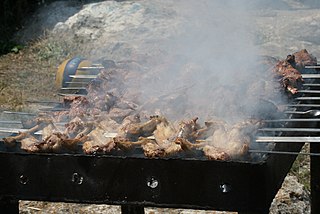 W
WKhorovats is a barbequed Armenian meat kebab. The meat may be marinated before grilling, but it does not have to be. It can be made with lamb, pork, beef, chicken, or even veal. This is generally a dish reserved for "festive occasions".
 W
WKibbeh is a family of dishes based on spiced ground meat, onions, and grain, popular in Middle Eastern cuisine.
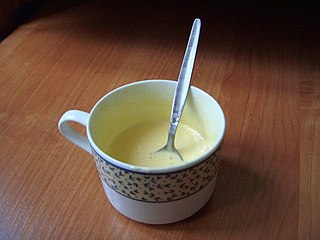 W
WKogel mogel is an egg-based homemade dessert once popular in parts of Europe and the Caucasus. It is made from egg yolks, sugar, and flavourings such as honey, vanilla, cocoa or rum, similar to eggnog or zabaione. In its classic form it is served slightly chilled or at room temperature. Served warm or hot, it is considered a home remedy for sore throats. Variations include milk, honey and soda.
 W
WLahmacun is a round, thin piece of dough topped with minced meat, minced vegetables and herbs including onions, garlic, tomatoes, red peppers, and parsley, and spices such as chili pepper, paprika, and cinnamon, then baked. Lahmacun is often wrapped around vegetables, including pickles, tomatoes, peppers, onions, lettuce, parsley, and roasted eggplant.
 W
WLula kebab is a type of kebab cooked on skewers. It is made from minced meat. It is a specialty of Armenian, Azerbaijani, and other cuisines of countries in South Caucasus, the Middle East, and Central Asia.
 W
WManti is a type of dumpling popular in most Armenian cuisines, as well as in the cuisines of the South Caucasus and Balkans, Central Asia, Afghanistan, Iran, Pakistan, Bukharian Jews and Chinese Muslims. Manti are also consumed throughout Russia and other post-Soviet countries, where the dish spread from the Central Asian republics. The dumplings typically consist of a spiced meat mixture, usually lamb or ground beef, in a thin dough wrapper and either boiled or steamed. Size and shape vary significantly depending on the geographical location. Manti resemble the Chinese jiaozi and baozi, Korean mandu, Mongolian buuz and the Tibetan momo and the dish's name is cognate with the Korean mandu, Chinese mantou and Japanese manjū, although the modern Chinese and Japanese counterparts refer to different dishes.
 W
WIn Armenian Christian tradition, matagh is a lamb or a rooster slated for slaughter as thanksgiving to God, a practice which has continued from Armenia's past. In many regions of Armenia today, this practice is very much alive in the regular slaughter of chosen animals in front of churches. Matagh is done often to ask God for either forgiveness, health, or to give him something in return. People generally gather at the house where the Matagh was done, where they pray and eat the meat. Tradition holds that the meat must be eaten before sundown and for any salt to be used to be blessed.
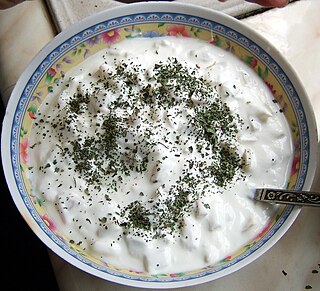 W
WMatzoon or matsoni is a fermented milk product of Armenian origin, distributed in Armenia and Georgia. In Japan, it is called Caspian Sea yogurt.
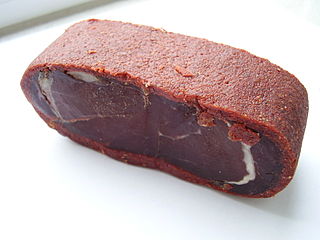 W
WPastirma or basturma, also called pastourma, basdirma, or basterma, is a highly seasoned, air-dried cured beef that is part of the cuisines of Turkey, Armenia, Bulgaria, Egypt, Greece, Iraq and North Macedonia.
 W
WPilau or Pilaf is a rice dish, or in some regions, a wheat dish, whose recipe usually involves cooking in stock or broth, adding spices, and other ingredients such as vegetables or meat, and employing some technique for achieving cooked grains that do not adhere.
 W
WSabzi khordan, kanachi,(Armenian: կանաչի), goy or pinjar is a common side dish in Iranian, Kurdish, Azerbaijani, Afghan, and Armenian cuisines, which may be served with any meal, consisting of any combination of a set of fresh herbs and raw vegetables. Basil, parsley, and radishes are among the most common ones.
 W
WSarma, commonly marketed as stuffed grape leaves, is a type of dolma—a stuffed dish of the cuisines of the former Ottoman Empire from the Middle East to Southeastern Europe—comprising grapevine, cabbage, monk's rhubarb, kale or chard leaves rolled around a filling of grains, minced meat, or both.
 W
WShashlik, or shashlyk, is a dish of skewered and grilled cubes of meat, similar to or synonymous with shish kebab. It is known traditionally by various other names in the Caucasus and Central Asia, and from the 19th century became popular as shashlik across much of the Russian Empire and nowadays in the Russian Federation and former Soviet republics.
 W
WSimit is a circular bread, typically encrusted with sesame seeds or, less commonly, poppy, flax or sunflower seeds, found across the cuisines of the former Ottoman Empire, and the Middle East. Simit's size, crunch, chewiness, and other characteristics vary slightly by region. It is widely known as Turkish bagel in the United States.
 W
WSujuk or sucuk is a dry, spicy and fermented sausage which is consumed in several Balkan, Middle Eastern and Central Asian cuisines. Sujuk mainly consists of ground meat and animal fat usually obtained from beef or lamb, but horse meat is also often used in Bulgaria, Kazakhstan and Kyrgyzstan.
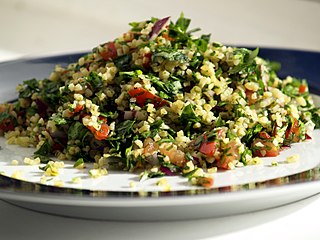 W
WTabbouleh is a Levantine salad made mostly of finely chopped parsley, with tomatoes, mint, onion, bulgur, and seasoned with olive oil, lemon juice, salt and sweet pepper. Some variations add lettuce, or use semolina instead of bulgur.
 W
WTahini or tahina is a Middle Eastern condiment made from toasted ground hulled sesame. It is served by itself or as a major ingredient in hummus, baba ghanoush, and halva.
 W
WA tahini roll or tahini bread roll is a sweet pastry found commonly in the cuisines of Armenia as Թահինով Հաց; Cyprus and Greece as ταχινόπιττα or τασιηνόπιττα; Turkey as tahinli çörek; and in Arab cuisine as khubz tahini. They are a popular street food in Cyprus.
 W
WA tandoor also known as tannour is predominantly a cylindrical clay or metal oven used in cooking and baking. The tandoor is used for cooking in Southern, Central, and Western Asia, as well as in the South Caucasus.
 W
WTorshi are the pickled vegetables of many Middle Eastern and Balkan cuisines.
 W
WZankou Chicken is a small, family-owned chain of Armenian and Mediterranean fast casual restaurants within the Los Angeles area. The restaurants are especially known for their spit-roasted chicken, shawarma, falafel, tahini, and a "secret" garlic sauce.